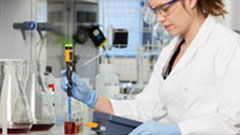pH measurements
pH measurements using a pH meter can only be correct and precise when you are using the right buffer for your instrument. Depending on the instrument and your pH measurement range, different buffer solutions and different temperatures can be required. Whatever your requirements are, we have a pH buffer solution that matches your needs.
Several improvements have been made in the pH buffer range to make your life easier:
- Colored solutions for easy recognition of the correct solution
- pH buffer solutions in sachets to ensure a 'fresh' solution every time you measure
- pH buffer solutions measured at 25 degrees Celcius to meet your temperature requirements (temperature deviation table still available)
Product Categories

pH buffer in sachets
The right buffer value in your pocket.Ideal for the exact calibration of your pH-meters ! Buffers, produced by an accredited ISO 17034 supplier, freshness sealed, easy to use, reliable and accurate, traceable to NIST

pH buffer at 20°C
A complete range of PH Buffer solutions produced by an accredited ISO 17034 supplier, traceable to NIST available in a large variety of formats and packs from 100ml until 20l

pH buffer coloured solutions
Identify easily your ph solutions with a special colour is a huge advantage to avoid calibration mistakes

pH buffer secondary standards
A very large range of buffers very accurate, Traceable to NIST, DIN 19266 and IUPAC

pH test strips
Need to get a quick idea of the pH range of a solution? pH strips are quick and easy to use.

Cleaning and maintenance solutions
Cleaning and storage solutions for pH electrodes.
FAQ
You need a pH electrode and at least two pH buffers, one at pH 7 and the other at pH 4 or 10. Optional accessories that will prolong the life of your electrode include: Storage solution, soaker bottles and cleaning solution.
There are two ways to test for pH:
1. pH strips or indicator paper
2. pH meter and electrodes
If you want to measure pH in the field and transport the pH meter from place to place, you have to use a battery. If the meter is stationary, as in a lab, choose a bench top version.
The best solution for storage is 4 M KCL. pH 4 buffer, pH 7 buffer or tap water will also work as a storage solution. Caution: Never store your electrode in distilled water.
Our recommendations are that you calibrate each time you use it or each set of uses.
Yes. There are two main advantages to slowly stirring or gently agitating the sample during a pH measurement. First, the increased flow of the sample across the electrode results in a faster response time. Second, the solution is properly homogenated so no areas of increased or decreased pH exist.
Prepare the sample by combining a 5 g of a soil sample with 5 g of distilled water, mixing thoroughly and allowing the mixture to settle for 10 minutes. Carefully insert the probe so the bulb is in the soil and the junction is in the supernatant. Allow the reading to stabilise.
The only way to measure the pH of gas is to dissolve it into distilled water and measure the mixture.
- ISO 17034-2016 for suppliers means that all the buffers are produced and tested by an expert ensuring you can totally rely on the quality of these products.
- Accreditation is based on the presence of a competent testing lab, where not only qualified staff have to be employed, but where each and every analysis carried out has to correspond to specified criteria.
- All instrumentation used is regularly checked by officially authorised calibration laboratories.
- All relevant parameters used in measurement (Weight and T°) correspond to national and international standards.
- General requirements for the competence and consistent operation of reference material production.
- All methods that the manufacturer uses to certify their standards must be validated and proven to be accurate.
Literature
Additional Resource

Electrochemistry
Also looking for a new pH meter? Take a look at our offer here:
 Promotions
Promotions
